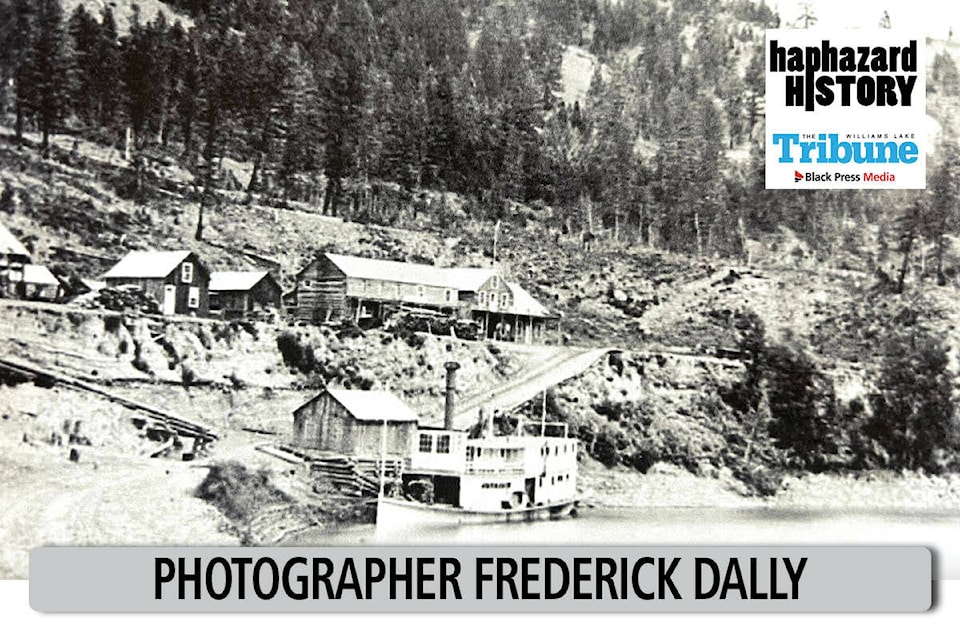Most of us have seen the iconic photograph of two freight wagons being pulled by mules through the Great Bluff cut above the Thompson River, or the equally famous photo of the S.S. Enterprise at its berth on the Fraser River below the town of Soda Creek. Both of these images were captured for posterity in 1867 by Frederick Dally.
As I write these columns about people and places in the gold rush era, I frequently check the provincial archives to find related photographs. I have noticed that very often, these old images are attributed to this man, who has become known as “the Gold Rush Photographer.” So, who was Frederick Dally, and what is his story? I thought that the answers to these questions might make for some interesting reading.
Not much is known about Dally’s early years. He was born on July 29, 1838 in Southwark, a district of greater London, the youngest of nine children. He received his education at Christ’s Hospital in London and served an apprenticeship with a linen and woolen draper. In 1862, at the age of 24, and at the height of the Cariboo Gold Rush, Dally emigrated to Victoria, the capital of the new Colony of British Columbia. There, he opened up a dry goods store, selling everything from cloth to engravings to wine goblets and musical instruments.
Dally had a keen interest in the relatively new art of photography, and almost four years later, in June of 1866, he sold his successful dry goods business and he established his own photographic studio and gallery. Gradually, this business grew as he produced portraits of the city’s leading citizens, images of public buildings, and informal photographs of local street scenes and special community events. He also produced an extensive collection of photographic plates documenting the activities of the colonial government and the Royal Navy, based at Esquimault. One of his specialties was producing and marketing “cartes des visites” of First Nations people – photographs of his encounters with Indigenous people in their own villages.
In August of 1866, Dally accompanied the Governor of the Colony, Arthur Edward Kennedy, aboard the H.M.S. Scout as they circumnavigated Vancouver Island and stopped off at many First Nations villages. His photographs taken on this trip especially those from Fort Rupert (Port Hardy), Comox, Cowichan, and Nanaimo were outstanding and continue to provide valuable anthropological evidence even today.
The following year, in 1867, Dally made a month-long trip up the Cariboo Wagon Road to Barkerville and the Cariboo gold fields. He took photographs all along the route as well as recording images of Barkerville itself and the mining operations in the vicinity of Williams Creek.
It must have been exceedingly difficult for a photographer travelling in the mid 1860s. He would have had a huge, heavy camera, a large tripod, dozens of glass plates, a trunk full of chemicals, distilled water, and developing trays, and a darkroom tent in which to develop his photographs. What a difference from today’s instant images on our cell phones! Despite the high degree of difficulty, Dally managed to produce some of the finest Canadian photographs of the 1860s. In particular, his work in and around Barkerville was exceptional. Many of photos were used to produce engravings for pictures published by the press outlets of the day, and many others have been used, and still are being used today, to illustrate books and articles dealing with our province’s history.
The following year, in July of 1868, Dally returned to Barkerville to open up a new photographic studio and gallery there. Its construction was completed a month or so later, and business was brisk. Dally produced a number of photos of the people and the area, but the whole enterprise came to an abrupt end when fire destroyed the town on September 16.
Rather than going through the expense and difficulties of rebuilding, Dally returned to Victoria at the end of October. There he continued to operate his photography business until September, 1870, when he sold his gallery and all his equipment to the Green brothers. Unfortunately, his glass plate negatives and his albums of photographs were dispersed. They are still being sought today.
After he sold out, Dally made his way to Philadelphia, where he studied to become a dental surgeon. Two years after receiving his degree, he returned to England, where he set up a practice in Portman Square, London. Later on, he moved to Wolverhampton, where he continued as a very successful and well recognized dental surgeon until his retirement at the age of 71.
During this time, he offered his expertise on colonial British Columbia, and also the photographic collections he had personally kept, to the Royal Geographic Society and the British Museum. In 1883, he presented an album of his images to Queen Victoria in person.
Frederick Dally died in Wolverhampton on July 28, 1914 in his 76th year. No other photographer had compiled such a complete record or set of images of the early years of our province. At a time when photography was crude and uncertain at best, his images were remarkable for their clarity, their composition, and their subject matter. Were it not for “the Gold Rush Photographer,” we would have a far more incomplete visual record of our historical past.
Read More: A Haphazard History of the Fraser River Bridge
Do you have a comment about this story? email:
editor@wltribune.com
Like us on Facebook and follow us on Twitter.
